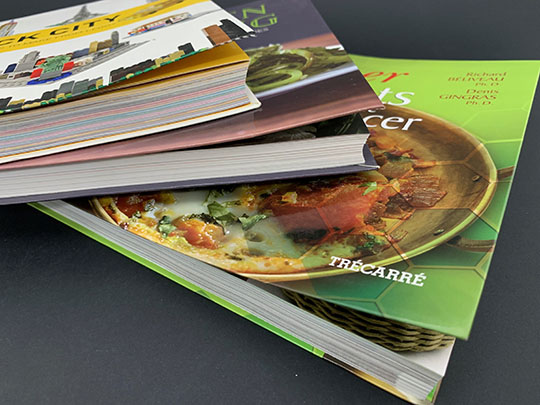Soft covered case bound books almost sound like a contradiction of terms. Soft covered case bound books are exactly the same as hard back case bound books except for the fact that hard covered case bound books have a paper based “board” inside the cover and the soft cover style has no board.
Both styles have the cover material “wrapped around” all four sides and the front and back end paper is mounted (or glued) to the inside front and back cover. These soft cover (limp) covered books are slightly cheaper than similar books with “boards” in the cover.
When I have asked different people as to why they like and specify this style, the response is that these books are “different” and “they feel better when handled” (their words not mine).
Exploring the Appeal of Soft Covered Case Bound Books
In the world of bookbinding, there exists a subtle yet intriguing variation that often catches the attention of bibliophiles and casual readers alike: the soft covered case bound book. At first glance, the combination of soft cover and sturdy binding might seem paradoxical, but delve deeper, and you’ll find a unique charm and practicality that distinguishes this style from its hardcover counterpart.
In essence, soft covered case bound books share many similarities with their hardback siblings. Both boast the enduring construction of case binding, a method wherein the cover material envelops the text block, providing durability and longevity. However, the point of departure lies in the absence of a traditional paper-based board within the soft cover variant.
The defining feature of soft covered case bound books is their flexibility. Without the rigid board, these volumes acquire a supple quality, molding effortlessly to the reader’s hands. This tactile sensation, often described as more organic and comfortable, sets them apart from their stiffer counterparts. As one enthusiast aptly put it, they “feel better when handled.”
Beyond the sensory experience, soft covered case bound books offer pragmatic advantages as well. Their construction renders them slightly more economical compared to their hardcover equivalents. This affordability makes them an appealing choice for publishers seeking to balance quality with cost-effectiveness without compromising on durability.
Furthermore, there’s an undeniable allure to the unconventional nature of these books. In a market saturated with standard hardcovers, opting for a soft cover variation adds a touch of uniqueness to one’s collection. The subtle deviation from the norm serves as a testament to the individuality of both the reader and the book itself.
When querying aficionados about their preference for soft covered case bound books, one frequently encounters sentiments of admiration for their distinctiveness. Readers appreciate the deviation from the ordinary and the opportunity to engage with literature in a slightly unconventional manner. For them, these books represent a departure from the expected—a chance to embrace something refreshingly different.
It’s worth noting that the soft cover variant does not compromise on quality. Despite the absence of the board, the binding ensures that the pages remain secure and intact, promising years of enjoyable reading experiences. Moreover, the mounting or gluing of front and back endpapers to the inside covers enhances both the aesthetics and the structural integrity of the book.
In conclusion, soft covered case bound books occupy a unique niche in the realm of bookbinding, marrying the durability of case binding with the flexibility and affordability of soft covers. Their appeal lies not only in their tactile qualities but also in their capacity to defy convention and offer readers a distinctive literary experience. So, the next time you’re perusing your library or bookstore, consider adding a soft covered case bound book to your collection—you might just find yourself pleasantly surprised by the tactile pleasure and charm it brings to your reading adventures.
Soft Book Case Making
This week, I’m featuring soft covered case bound books, which have the durability of hardcover cases but the flexibility of a paper book cover. This particular book has a smyth sewn book block that has rounded corners and foil edge gilding.
Both soft and hard book covers have the four edges of the cover material turned in and then glued to the front and back book endpapers. Hardcovers simply have pieces of 100pt board mounted between the cover materials and the endpapers.
We have newly installed casing-in and case making machines, which produce quality case wrapped book covers at amazing speeds.

We offer many other services that enhance case wrapped books, including:
- Ribbon bookmarks (hundreds of combinations of widths, colours and trimming styles)
- Foil stamping
- Foil edge gilding
- Round book cornering
- Slipcases and book boxes
You might have a supplier for case wrapped book covers, but please give us a call!



